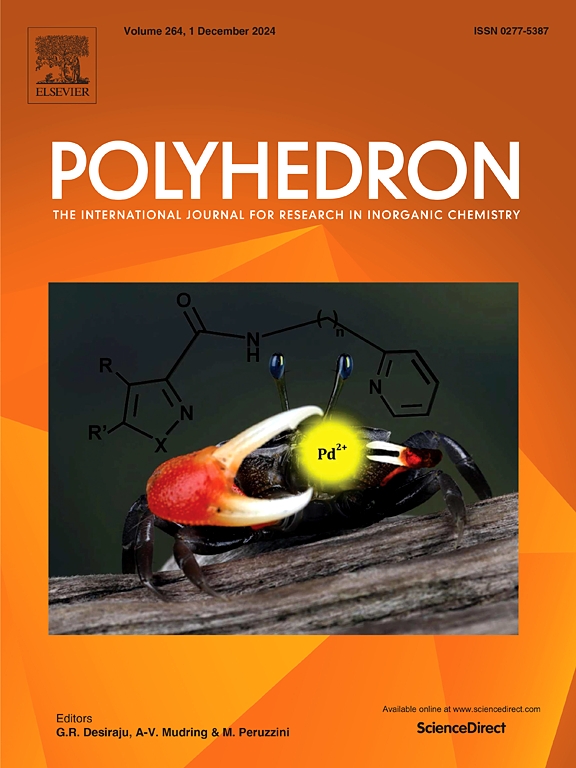染料降解的有效吸附工具:绿色磁铁矿纳米颗粒
IF 2.4
3区 化学
Q2 CHEMISTRY, INORGANIC & NUCLEAR
引用次数: 0
摘要
本研究的目的是利用绿色合成磁铁矿纳米颗粒和林地叶提取物(WEFe3O4NPs)作为吸附剂,吸附去除水溶液中的阳离子染料亚甲基蓝。采用UV-Vis、FTIR、XRD、SEM-EDX、TEM-SAED、BET、VSM和TGA对WEFe3O4NPs的形貌和颗粒特征进行了光谱、光学、磁和生理分析。在接触时间、初始亚甲基蓝(MB)浓度、吸附剂用量和ph等不同的实验条件下进行了批量吸附研究。Freundlich等温线与伪一阶等温线结合实验数据分析了伪二级动力学模型。结果表明,在pH为11、接触时间为150 min时,WEFe3O4NPs对亚甲基蓝的吸附效果最佳。在此条件下,当初始染料浓度为5 mg/L时,最大去除率为91%。Langmuir和拟二阶动力学模型拟合了实验数据,表明了化学吸附和单层过程。此外,本文还对不同生物提取物制备的Fe3O4 NPs吸附亚甲基蓝的效率进行了比较研究。这些结果证实了WEFe3O4NPs作为废水中MB染料的有效吸附剂具有很大的潜力。本文章由计算机程序翻译,如有差异,请以英文原文为准。

An efficient adsorptive tool for dye degradation: Green magnetite nanoparticles
This research aims the adsorptive removal of methylene blue, a cationic dye from aqueous solutions using green synthesized magnetite nanoparticles with an aqueous leaf extract of Woodland Elaeocarpus (WEFe3O4NPs) as an adsorbent. The morphology and particle characteristics of WEFe3O4NPs are analysed by spectral, optical, magnetic and physiological studies using UV–Vis, FTIR, XRD, SEM-EDX, TEM-SAED, BET, VSM, and TGA respectively. Batch adsorption studies were carried out under varying experimental conditions of contact time, initial methylene blue (MB) concentration, adsorbent dosage and pH. Langmuir & Freundlich isotherms and Pseudo first order & Pseudo second order kinetic models were analysed with the experimental data. The results indicated that at pH of 11 and contact time of 150 min were optimal for the methylene blue adsorption onto WEFe3O4NPs. With these optimal conditions, the study achieved a maximum removal efficiency of 91% for an initial dye concentration of 5 mg/L. The experimental data was suitably fitted by the Langmuir and pseudo-second order kinetic model denoting a chemisorption and a monolayer process. Further, this article provides the comparative study on efficiency of various Fe3O4 NPs derived from bio-extracts in adsorptive expulsion of methylene blue. These findings confirm that WEFe3O4NPs hold great potential as an effective adsorbent for MB dye from wastewater.
求助全文
通过发布文献求助,成功后即可免费获取论文全文。
去求助
来源期刊

Polyhedron
化学-晶体学
CiteScore
4.90
自引率
7.70%
发文量
515
审稿时长
2 months
期刊介绍:
Polyhedron publishes original, fundamental, experimental and theoretical work of the highest quality in all the major areas of inorganic chemistry. This includes synthetic chemistry, coordination chemistry, organometallic chemistry, bioinorganic chemistry, and solid-state and materials chemistry.
Papers should be significant pieces of work, and all new compounds must be appropriately characterized. The inclusion of single-crystal X-ray structural data is strongly encouraged, but papers reporting only the X-ray structure determination of a single compound will usually not be considered. Papers on solid-state or materials chemistry will be expected to have a significant molecular chemistry component (such as the synthesis and characterization of the molecular precursors and/or a systematic study of the use of different precursors or reaction conditions) or demonstrate a cutting-edge application (for example inorganic materials for energy applications). Papers dealing only with stability constants are not considered.
 求助内容:
求助内容: 应助结果提醒方式:
应助结果提醒方式:


